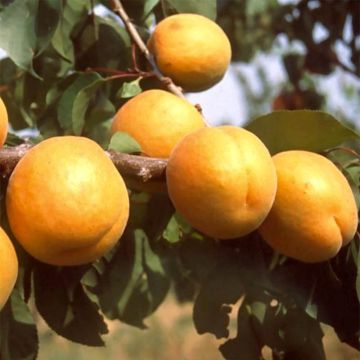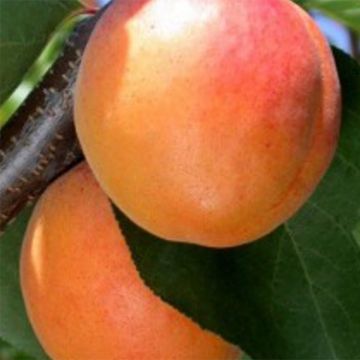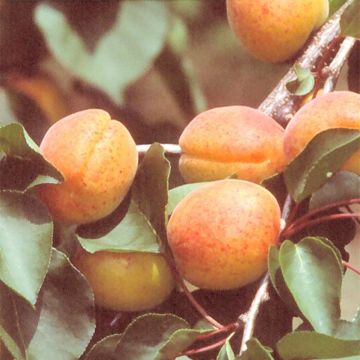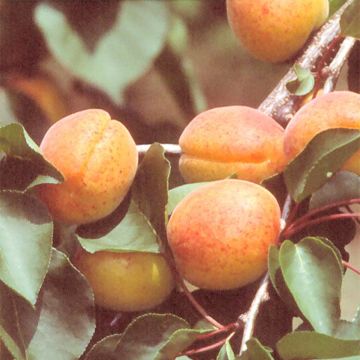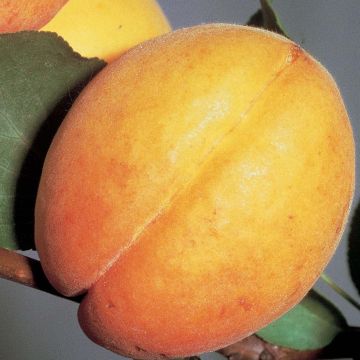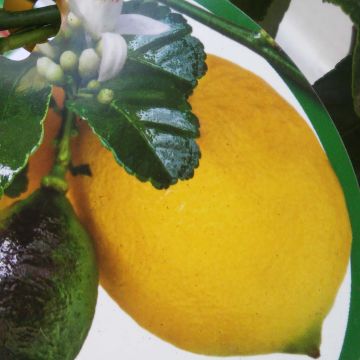

Abricotier nain Fruit Me Apricot Me Pending


Abricotier nain Fruit Me Apricot Me Pending
Prunus armeniaca Fruit Me Apricot Me Pending - Apricot Tree
Prunus armeniaca Fruit Me® Apricot Me Pending
Apricot
Why not try an alternative variety in stock?
View all →This plant carries a 6 months recovery warranty
More information
We guarantee the quality of our plants for a full growing cycle, and will replace at our expense any plant that fails to recover under normal climatic and planting conditions.
From €5.90 for pickup delivery and €6.90 for home delivery
Express home delivery from €8.90.
From €5.90 for pickup delivery and €6.90 for home delivery
Express home delivery from €8.90.

Description
The Dwarf Apricot Tree Fruit Me Apricot Me Pending is decorative with its spectacular spring flowering and is characterized by its amazing ability to adapt its growth to the volume of soil available. It is suitable for gardens with limited space, for growing in containers on balconies or terraces, or for creating a small fruit hedge. Thanks to its small size, harvesting is simplified. It quickly bears fruit, offering a harvest of large apricots, measuring 5 to 6 cm (2in) in diameter and weighing about 40 to 50 grams, with an oblong shape. The velvety skin, orange-red in colour, encloses firm, juicy, sweet, and slightly acidic flesh around a flattened and rough stone containing an edible obovate kernel. This hardy (up to -15°C (5°F)), disease-resistant mini-apricot tree requires no pruning and is easy to grow with little maintenance. It is self-fertile and can pollinate itself.
Prunus armeniaca, commonly known as the Common Apricot Tree, belongs to the Rosaceae family, like the peach tree, cherry tree, and apple tree. It originates from Central and Eastern Asia, particularly China, where it has been cultivated since 3000 BC. It was introduced to the Mediterranean region, especially Armenia, and then to France in the 16th century.
The variety Fruit Me Apricot Me Pending is part of a very innovative series of semi-dwarf fruit trees recently developed in Spain. The use of appropriate grafting techniques on a very specific, latest-generation rootstock allows this fruit tree to adapt to the available soil volume while ensuring quality fruit production from the first years of cultivation. This mini-apricot tree has the ability to adjust its growth depending on the growing location. When planted in the ground, it develops a semi-erect, well-branched, and well-aerated habit, reaching a height of about 2 to 2.50 metres (7 to 8 feet) with a spread of 1.5 metres (5 feet) at maturity. In a container, it will not exceed 1.50 metres (5 feet) in height and 1 metre (3 feet) in width.
Its deciduous foliage consists of alternate, oval to elliptical leaves, 6 to 10 cm (2 to 4in) long, with a heart shape and irregularly toothed edges. The leaves emerge bronze and then turn shiny medium green, taking on yellow-orange autumn hues. The early flowering occurs in mid-March, before the leaves appear, which can expose it to spring frosts. The white-pink flowers, 2 to 3 cm (1in) in diameter, are solitary and appear on one-year-old branches. They can be damaged by frost at temperatures ranging from -2 to -3°C (28.4 to 26.6°F), so it is recommended to plant apricot trees in sheltered, west-facing locations protected from cold winds in regions with late frosts. However, the abundant flowering often leads to satisfactory fruit production. It is a remarkably decorative flowering tree in spring and is particularly attractive to bees and other pollinators. This hardy tree, which can withstand temperatures of around -15°C (5°F), is suitable for cultivation in all regions of France. It is said to be self-fertile, as its flowers can self-pollinate, but having another variety of apricot tree nearby will increase production.
The Fruit Me Apricot Me Pending is a very productive variety, bearing fruit quickly, around 2 to 3 years, and reaching optimal production after 5 to 6 years. The fruit is attached to the branch by a very short stem. Harvesting begins in mid-July and extends until early August. It is important to pick the fruit only when it is ripe, when it is golden, tender to the touch, and easy to detach from the tree. Apricots are simply harvested by hand, with delicacy.
Juicy, sweet, and subtly acidic, this apricot is delicious when eaten fresh, immediately after harvesting, as it does not keep well. In cooking, it reveals all its flavors in the preparation of clafoutis, cakes, crumbles, tarts, fruit salads, and as an accompaniment to savory dishes with white meats (turkey, chicken, veal, duck, rabbit, etc.) or cheese. They are also perfect for making jams, marmalades, jellies, preserved in syrup, or canned. Apricot juice is refreshing and can be mixed with a touch of peach juice to balance the natural acidity of the apricot. Its high content of beta-carotene, vitamins A, B, and C, phenolic antioxidants, calcium, magnesium, potassium, and a significant amount of iron, as well as its richness in trace elements and fibers, make apricot a health asset. The fruits can be stored for 2 to 3 weeks in a cool, airy place or in the refrigerator. They can also be frozen or dried after being washed and pitted.
Apricot is a summer fruit loved by both young and old. Among a wide range of apricot trees, it is easy to find the variety that best suits one's desires or needs. This mini-apricot tree, Apricot Me Pending, like all the fruit trees in the Fruit Me range, is also easy to grow, hardy, reliable, disease-resistant, and allows for the creation of a miniature orchard on a patio or balcony.
Report an error about the product description
Prunus armeniaca Fruit Me Apricot Me Pending - Apricot Tree in pictures
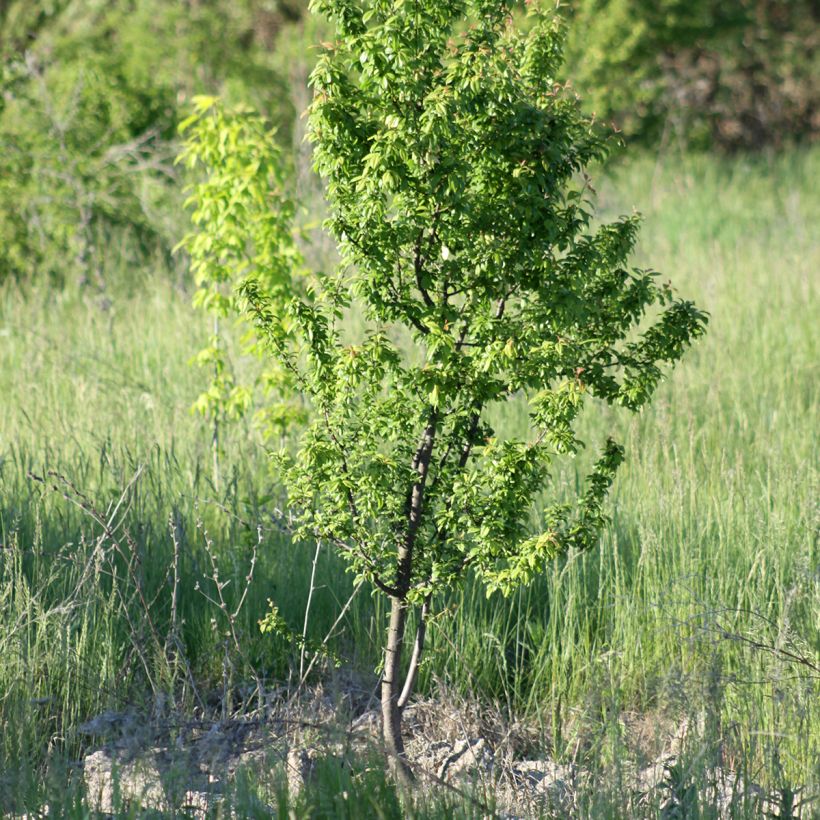



Plant habit
Fruit
Flowering
Foliage
Botanical data
Prunus
armeniaca
Fruit Me® Apricot Me Pending
Rosaceae
Apricot
Cultivar or hybrid
Other Apricot trees
Planting and care
Easy to grow, the Apricot Tree Fruit Me Apricot Me Pending grows in all types of soils, including rocky and slightly chalky soils. It appreciates damp, light soils and fears heavy and clay soils. Choose a sunny exposure. In order to limit the risks of late frosts on the flowers, it is recommended to plant the apricot tree in a sheltered position, facing west and protected from cold winds in regions that experience spring frosts. Planting is preferably done in autumn or, failing that, in winter when the tree is in vegetative rest, outside the freezing period. If you plant multiple plants, space them 2 to 3 meters (7 to 10 feet) apart for dwarf varieties.
Loosen the soil deeply, remove rocks and unwanted herbs. Add some sand to improve drainage. Dig a hole 4 to 5 times the volume of the root ball. Make sure to separate the subsoil and the topsoil. Mix bonemeal or well-rotted compost or potting soil with the subsoil and pour this mixture into the planting hole. Install a stake. Place the root ball, cover with the topsoil and tamp well. Water generously (about 10 liters). Position your tie system, crossing it in the shape of an 8, so that the trunk and the stake do not rub against each other.
During cultivation, watering is not necessary except in case of extreme heat. Mulch at the base to keep cool in summer.
For container planting: place a layer of gravel or clay pellets at the bottom of the pot to facilitate drainage. Add a layer of soil and then place the plant and cover with a mixture of 2/3 garden soil, 1/3 potting soil or well-rotted compost. Every spring, replace the surface layer with fresh potting soil. Water regularly and moderately. At the end of autumn, protect the pot with insulation before winter frosts.
The apricot tree can be susceptible to different diseases.
Planting period
Intended location
Care
-
, onOrder confirmed
Reply from on Promesse de fleurs
Mediterranean fruit trees
Haven't found what you were looking for?
Hardiness is the lowest winter temperature a plant can endure without suffering serious damage or even dying. However, hardiness is affected by location (a sheltered area, such as a patio), protection (winter cover) and soil type (hardiness is improved by well-drained soil).

Photo Sharing Terms & Conditions
In order to encourage gardeners to interact and share their experiences, Promesse de fleurs offers various media enabling content to be uploaded onto its Site - in particular via the ‘Photo sharing’ module.
The User agrees to refrain from:
- Posting any content that is illegal, prejudicial, insulting, racist, inciteful to hatred, revisionist, contrary to public decency, that infringes on privacy or on the privacy rights of third parties, in particular the publicity rights of persons and goods, intellectual property rights, or the right to privacy.
- Submitting content on behalf of a third party;
- Impersonate the identity of a third party and/or publish any personal information about a third party;
In general, the User undertakes to refrain from any unethical behaviour.
All Content (in particular text, comments, files, images, photos, videos, creative works, etc.), which may be subject to property or intellectual property rights, image or other private rights, shall remain the property of the User, subject to the limited rights granted by the terms of the licence granted by Promesse de fleurs as stated below. Users are at liberty to publish or not to publish such Content on the Site, notably via the ‘Photo Sharing’ facility, and accept that this Content shall be made public and freely accessible, notably on the Internet.
Users further acknowledge, undertake to have ,and guarantee that they hold all necessary rights and permissions to publish such material on the Site, in particular with regard to the legislation in force pertaining to any privacy, property, intellectual property, image, or contractual rights, or rights of any other nature. By publishing such Content on the Site, Users acknowledge accepting full liability as publishers of the Content within the meaning of the law, and grant Promesse de fleurs, free of charge, an inclusive, worldwide licence for the said Content for the entire duration of its publication, including all reproduction, representation, up/downloading, displaying, performing, transmission, and storage rights.
Users also grant permission for their name to be linked to the Content and accept that this link may not always be made available.
By engaging in posting material, Users consent to their Content becoming automatically accessible on the Internet, in particular on other sites and/or blogs and/or web pages of the Promesse de fleurs site, including in particular social pages and the Promesse de fleurs catalogue.
Users may secure the removal of entrusted content free of charge by issuing a simple request via our contact form.
The flowering period indicated on our website applies to countries and regions located in USDA zone 8 (France, the United Kingdom, Ireland, the Netherlands, etc.)
It will vary according to where you live:
- In zones 9 to 10 (Italy, Spain, Greece, etc.), flowering will occur about 2 to 4 weeks earlier.
- In zones 6 to 7 (Germany, Poland, Slovenia, and lower mountainous regions), flowering will be delayed by 2 to 3 weeks.
- In zone 5 (Central Europe, Scandinavia), blooming will be delayed by 3 to 5 weeks.
In temperate climates, pruning of spring-flowering shrubs (forsythia, spireas, etc.) should be done just after flowering.
Pruning of summer-flowering shrubs (Indian Lilac, Perovskia, etc.) can be done in winter or spring.
In cold regions as well as with frost-sensitive plants, avoid pruning too early when severe frosts may still occur.
The planting period indicated on our website applies to countries and regions located in USDA zone 8 (France, United Kingdom, Ireland, Netherlands).
It will vary according to where you live:
- In Mediterranean zones (Marseille, Madrid, Milan, etc.), autumn and winter are the best planting periods.
- In continental zones (Strasbourg, Munich, Vienna, etc.), delay planting by 2 to 3 weeks in spring and bring it forward by 2 to 4 weeks in autumn.
- In mountainous regions (the Alps, Pyrenees, Carpathians, etc.), it is best to plant in late spring (May-June) or late summer (August-September).
The harvesting period indicated on our website applies to countries and regions in USDA zone 8 (France, England, Ireland, the Netherlands).
In colder areas (Scandinavia, Poland, Austria...) fruit and vegetable harvests are likely to be delayed by 3-4 weeks.
In warmer areas (Italy, Spain, Greece, etc.), harvesting will probably take place earlier, depending on weather conditions.
The sowing periods indicated on our website apply to countries and regions within USDA Zone 8 (France, UK, Ireland, Netherlands).
In colder areas (Scandinavia, Poland, Austria...), delay any outdoor sowing by 3-4 weeks, or sow under glass.
In warmer climes (Italy, Spain, Greece, etc.), bring outdoor sowing forward by a few weeks.




































